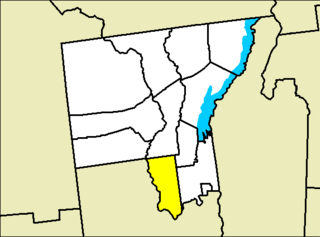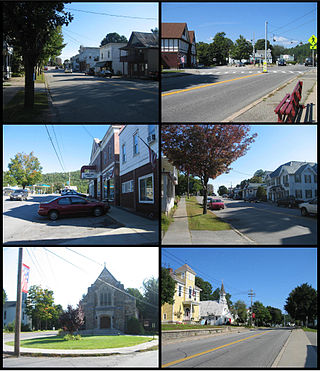
Warren County is a county in the U.S. state of New York. As of the 2020 census, the population was 65,737. The county seat is Queensbury. The county was established in 1813 and is named in honor of General Joseph Warren, an American Revolutionary War hero of the Battle of Bunker Hill. The county is part of the Capital District region of the state.

Au Sable Forks is a hamlet in Clinton County and Essex County, New York, United States. The northern half of the community, within Clinton County, is listed as the Au Sable Forks census-designated place (CDP) and had a population of 559 at the 2010 census.

Minerva is a town in Essex County, New York, United States. The population was 773 at the 2020 census. The town is named after Minerva, the Roman goddess of wisdom. The town has a highly irregular polygonal shape. It is located in the southwestern corner of the county. By road, it is 40 miles (64 km) north-northwest of Queensbury, 85 miles (137 km) southwest of Burlington, Vermont, 88 miles (142 km) south of Plattsburgh, 93 miles (150 km) north of Albany, and 147 miles (237 km) south of Montreal, Quebec.

North Hudson is a town in Essex County, New York, United States. The population was 240 at the 2010 census. The town derives its name by being near the northern end of the Hudson River.

Schroon is a town in the Adirondack Park, in Essex County, New York, United States. The population was 1,880 at the 2020 census. The largest community in the town is the hamlet of Schroon Lake, located at the northern end of the lake of the same name.

Wells is a town in Hamilton County, New York, United States. The population was 674 at the 2010 census. The town is named after Joshua Wells, a land agent, who built the first mills in the area. It is in the Adirondack Park and on the eastern border of the county. It is northwest of Schenectady.

Moreau is a town in Saratoga County, New York, United States. The population was 16,202 at the 2020 census. The town is located in the northeast part of the county, north of Saratoga Springs. Moreau is named after Jean Victor Moreau, a French general, who visited the area just before the town was formed. The town contains a village called South Glens Falls.

Chester is a town in Warren County, New York, United States. It is part of the Glens Falls metropolitan area. The population was 3,086 at the 2020 census. The town is made up by communities of Chestertown and Pottersville.

Horicon is a town in Warren County, New York, United States. It is part of the Glens Falls Metropolitan Statistical Area. Horicon's population was 1,389 at the 2010 census.

Johnsburg is a town in the northwestern corner of Warren County, New York, United States. It is part of the Glens Falls Metropolitan Statistical Area. The town population was 2,143 at the 2020 census. The town is named after John Thurman, an early settler and founder. Johnsburg is the largest town in Warren County by area.

Lake Luzerne, formerly the Town of Fairfield and then Luzerne, is a town in southern Warren County, New York, United States. The town is located within the Adirondack Park. The town is part of the Glens Falls Metropolitan Statistical Area. Lake Luzerne is west of the city of Glens Falls. The town population was 3,079 at the 2020 census.

Stony Creek is a town in the southwestern part of Warren County, New York, United States. It is northwest of the city of Glens Falls and is part of the Glens Falls Metropolitan Statistical Area. The population was 767 at the 2010 census. The town is named for a creek that flows through it. Stony Creek is within the Adirondack Park.

Thurman is a town in the western part of Warren County, New York, United States. It is part of the Glens Falls Metropolitan Statistical Area. The town population was 1,199 at the 2000 census. The town is named after John Thurman, an early landowner. The town lies entirely inside the Adirondack Park.

Hudson Falls is a village located in Washington County, New York, United States. The village is in the southwest of the town of Kingsbury, on U.S. Route 4. Hudson Falls is part of the Glens Falls Metropolitan Statistical Area. As of the 2010 census, the village had a population of 7,281. It was the county seat of Washington County until 1994, when the county seat was moved to Fort Edward.

New York State Route 418 (NY 418) is a 3.50-mile (5.63 km) state highway located entirely within the Adirondack Park in Warren County, New York, in the United States. The route begins just west of the hamlet of Thurman Station, where Athol Road changes designations from County Route 4 (CR 4) to NY 418. It heads eastward through the towns of Thurman and Warrensburg, following the Schroon River to an intersection with U.S. Route 9 (US 9) in the hamlet of Warrensburg. All of NY 418 is part of the Dude Ranch Trail, a New York State Scenic Byway that runs through Warren County and Saratoga County.
Pottersville is a hamlet and census-designated place in Chester, Warren County, New York, United States. In the census of 2010, the population was 424. The town is located in Adirondack Park on U.S. Route 9. Pottersville is home to the largest marble cave entrance in the eastern United States..

Chestertown is a hamlet of the Town of Chester, in Warren County, New York, United States. It is located by the junction of Route 8 and U.S. Route 9, in the Adirondack Mountains. The population was 677 at the 2010 census, which lists the community as a census-designated place.
Schroon Lake is a hamlet and census-designated place (CDP) in the town of Schroon in Essex County, New York, United States. The population was 833 at the 2010 census, or just over half of the total population of the town of Schroon.

Lake George is a town in Warren County, New York, United States. The population was 3,502 at the 2020 census. The town is named after the lake, Lake George. The town is part of the Glens Falls Metropolitan Statistical Area.
Warrensburg is a census-designated place (CDP) in Warren County, New York, United States. The population was 3,045 at the 2020 census. It is part of the Glens Falls Metropolitan Statistical Area.



















